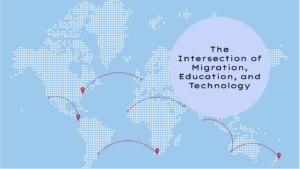
Migration and displacement are defining challenges of our era, reshaping societies and raising pressing questions about how to meet the needs of people on the move. Among these, access to education is fundamental, especially for refugees who face unique barriers to learning. In this blog, I introduce the themes of my proposed project and reflect on why integrating mobile education and lifelong learning models is essential to creating equitable and sustainable opportunities for displaced populations.
Education in the Context of Forced Displacement
Globally, millions of refugees experience disrupted education due to conflict, natural disasters, or persecution. This interruption often coincides with critical developmental stages for children and young adults, leaving them without the foundational skills needed to thrive in their host countries or return to their homelands. Traditional schooling systems, constrained by resources and geography, struggle to meet these needs. This is where technology can step in as a player for change.
Why Focus on Mobile Education?
Mobile education platforms offer unique advantages in refugee contexts:
Scalability: Mobile devices are widely used, even in under-resourced settings, making them a practical tool for delivering education at scale.
Accessibility: With asynchronous learning models, students can access educational resources anytime, overcoming barriers like limited school hours or remote locations.
Adaptability: Mobile technology enables multilingual, culturally sensitive content, addressing the diverse needs of displaced populations.
However, these benefits are not automatic. Barriers such as limited connectivity, low digital literacy, and the lack of culturally relevant materials must be addressed to make mobile education a viable solution.
The Role of Lifelong Learning
Lifelong learning is a concept that extends beyond formal education, encompassing non-formal and informal opportunities to acquire knowledge and skills throughout life. For refugees, this approach is transformative. It allows them to:
Bridge educational gaps caused by interrupted schooling.
Gain vocational skills for better economic integration.
Develop digital literacy, which is essential for navigating modern societies.
The UNESCO report Embracing a Culture of Lifelong Learning (2020) highlights that lifelong learning is essential to fostering resilience and adaptability in facing challenges like displacement. It emphasises a vision where education systems become flexible ecosystems that integrate formal, non-formal, and informal learning, enabling learners to navigate complex life courses. The report’s call for enabling environments through accessible technology, inclusive policies, and communal learning spaces is particularly relevant for refugee education.
Why This Research Matters
The intersection of migration, education, and technology is deeply personal. Teaching in various school settings exposed me to the challenges faced by migrant learners. These experiences highlighted the need for education systems that adapt to the realities of displacement, including systems that prioritise accessibility, flexibility, and inclusivity.
I aim to gain further insights into how mobile education and lifelong learning models can work together to provide equitable and sustainable educational opportunities for refugees? This inquiry is grounded in the belief that education is a fundamental right and a catalyst for resilience and hope.
Next Steps
Over the coming weeks, I will delve deeper into the components of this research, exploring case studies, barriers to e-inclusion, and scalable solutions. Drawing inspiration from UNESCO’s vision of lifelong learning as a human right and its emphasis on digital equity, I aim to propose actionable strategies to bridge educational gaps for displaced populations.
References:
UNESCO – Institute for Lifelong Learning (2020). Embracing a culture of lifelong learning . [online] Unesco.org. Available at: https://unesdoc.unesco.org/ark:/48223/pf0000374112.


hijyen belgesi
16 January 2025 — 16:49
Thank you so much.